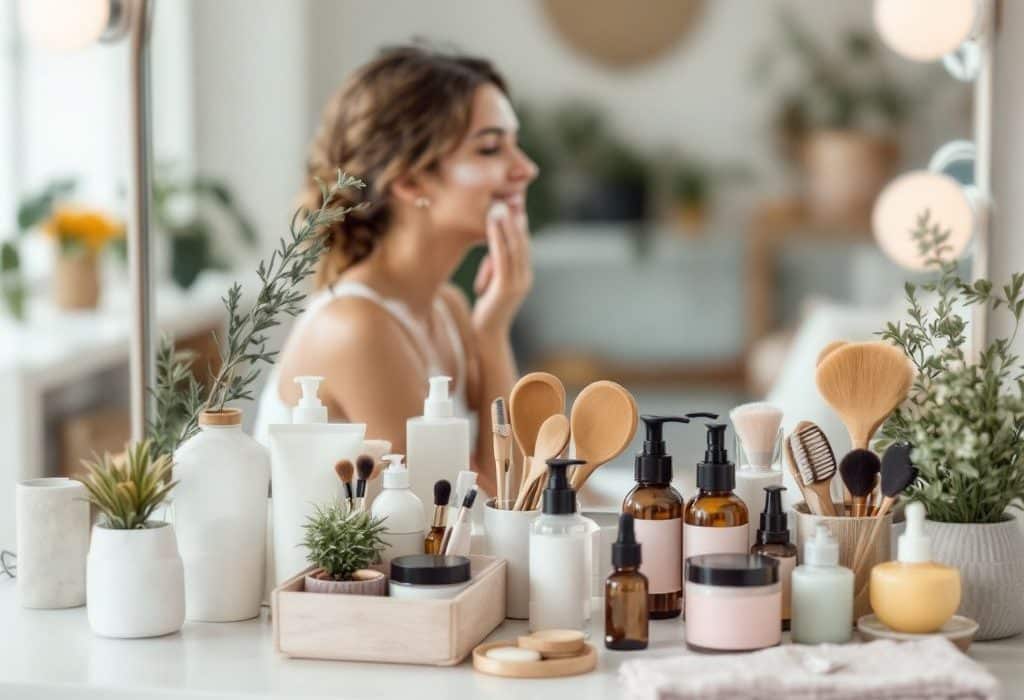Hey, skincare adventurers! Have you ever found yourself staring at your bathroom counter littered with a crew of chemical exfoliants, forever wondering how to make them play nice together? You’re not alone. Navigating the world of exfoliant layering can be a mystifying journey, but trust me, once you get the swing of it, your skin will sing praises. It’s a game-changer, folks!
Understanding the Basics of Chemical Exfoliants
Okay, let’s start by making friends with our chemical exfoliants — those little potion bottles holding AHAs, BHAs, and sometimes PHAs, trying to give us that glow-up. Chemical exfoliants gently break down the bonds holding your dead skin cells on your face, revealing fresher skin underneath. Think of them as those magic erasers for your face—just one swipe, and boom! Brighter, clearer skin.
Why Layer Chemical Exfoliants?
You might be thinking, “Why bother with exfoliant layering? Isn’t one chemical burn party enough?” Layering these exfoliants allows you to customize your routine for specific skin needs. Maybe you’re dealing with pesky zits on the T-zone while battling dullness in other areas. Layering lets you target multiple issues simultaneously, giving your skin everything it needs on different levels. It’s like putting puzzle pieces together that fit perfectly.
Know Your Exfoliants: A Quick Intro Guide
Let’s quickly breeze through the types of chemical exfoliants, so you know what you’re getting into:
- AHAs (Alpha Hydroxy Acids): These are water-soluble acids like glycolic acid and lactic acid. If your skin lacks oomph and looks dull, AHAs are just the thing. They help with pigmentation and skin texture.
- BHAs (Beta Hydroxy Acids): Enter salicylic acid, your best mate if you’re dealing with acne-prone or oily skin. BHAs dive deep into your pores, cleaning out all the debris.
- PHAs (Polyhydroxy Acids): The kinder cousin of AHAs, PHAs are perfect for sensitive skin. They exfoliate more gently, with larger molecules that don’t penetrate the skin as easily, so they minimize irritation.
Got it? Great! Let’s dive right into the exciting world of layering without further ado.

Your Exfoliant Layering Routine: Step by Step
Creating an effective routine is downright essential. So, how do we exactly become experts at this exfoliant fiesta? Here’s your roadmap.
Step 1: Double Cleansing
Begin with a clean canvas. Use an oil-based cleanser to dissolve makeup and sunscreen, then follow up with a gentle foaming cleanse. Think of this as clearing the stage for our star players (the exfoliants, obviously). It’s… cleansing zen.
Step 2: Listen To Your Skin
Before diving headlong, ask, “What does my skin need today?” Maybe it’s a texture boost or combatting stubborn blackheads. Identifying your skin goal will dictate your exfoliant play of the day.
Step 3: AHA and BHA Layering — Finding the Right Fit
Here’s where the real action happens. There’s no one-size-fits-all, but these insights help you get it right:

- If Dryness is a Real Drag: Try using a mild AHA like lactic acid during the evenings. It tackles uneven texture and pigment issues without leveling your moister barriers.
- For Acne Concerns: Consider a BHA, particularly in oilier zones. It’s like sending tiny pimple warriors once or twice a week on a search-and-destroy mission.
- Multitaskar Supreme: Some fans rave about using an AHA-BHA hybrid toner to target diverse concerns — a great once-a-week detox!
As you layer — start thin! Apply your AHA and give it a moment to absorb, then layer in that BHA like your skincare version of a cherry on top.
Step 4: Assign Roles – Don’t Overload Your Skin
Be wary of applying too many combative products. The golden rule is “less product, more impact.” Plan to alternate days if concerns persist about potential irritation. Monitor your skin’s response and lay low on exfoliants if irritation sneaks in.
Step 5: Lock it In
After the performance, treat your skin with some barrier-building hydration. A hydrating serum, packed with antioxidants, sets the stage for recovery. Layer with a nourishing moisturizer — IT SEALS THE DEAL! This way, all the hard work we’ve done doesn’t come undone.
Step 6: Anti-abbrasion Security – Sunscreen is Non-negotiable
Absolutely no skipping sun protection after exfoliating (it’s commandment numero uno, friends). The newfound fresh skin needs rigor-worthy SPF during the daytime hustle.

Tailor Your Routine—Mix and Match for Max Impact
Long story short, when it comes to layering chemical exfoliants, context matters. Your daily interactions, the climate — all those minute details, inform your choice. Spring may need a higher AHA focus, whereas summer asks for tighter BHA action on oil congestions from increased humidity.
Common Mistakes to Dodge
Alright, friend, let’s talk pitfalls. Here’re actions to avoid, else you’ll be a sitting duck overloading sensitivity.
- Combining New Products All at Once: Skincare ain’t a competition race. Take your time; patch-test newcomers before officially inducting them into the routine.
- Neglecting Patch Tests: Particularly with sensitive skin, it takes nothing more than a dime-sized squeezed dollop to ascertain compatibility.
- Poor Product Integration: Uninvited mix-turology occurs when wrong pH levels fight each other. Balance, and blend thoughtfully, my dear Watson!
- Ignoring Barrier Care: Following exfoliation, an intro measure a good moisturizer! If you skip out on post-care, you’re fighting half uncovered.
Closing Thoughts on Exfoliant Layering
Ah, and there you have it! The delightful world of exfoliant layering, navigated with finesse. At first, it might seem complex, almost like learning the steps to an elaborate dance, but soon enough, you’ll waltz your way around confidently with shining, healthy skin.
Keep listening to your skin — its whispers share clues far better than any skincare oracle. Step gently into the world of acids, tailorably calibrating your routine as your skin serenades to your exfoliant layering expertise. Before you know it, you’ll be teaching your friends, bragging about your oh-so-gleaming visage. Until next time—happy layering!
Frequently Asked Questions
What is the correct order for using exfoliants in my skincare routine?
It is generally recommended to cleanse your face before exfoliating. Cleansing removes surface debris, allowing exfoliants to access and remove dead skin cells more effectively. After cleansing, apply your exfoliant, and then follow up with a moisturizer and sunscreen if necessary[3][4].
How often should I exfoliate my skin?
The frequency of exfoliation depends on your skin type and needs. Typically, exfoliating one to three times per week is recommended. For sensitive skin, it may be best to start with once a week and adjust as needed. For oily skin or skin with specific concerns like acne, more frequent exfoliation might be beneficial, but it’s crucial to avoid over-exfoliating[2][3].
What are the different types of exfoliants, and which one is best for my skin type?
There are two main types of exfoliants: mechanical and chemical. Mechanical exfoliants use physical tools like scrubs, brushes, or sponges to remove dead skin cells. Chemical exfoliants, such as alpha-hydroxy acids (AHAs) like glycolic acid and lactic acid, or beta-hydroxy acids (BHAs) like salicylic acid, dissolve the bonds between dead skin cells. For oily skin, salicylic acid or glycolic acid can be beneficial. For dry or sensitive skin, lactic acid or malic acid may be more suitable[2][3].
How does exfoliation impact the effectiveness of other skincare products?
Exfoliation enhances the effectiveness of other skincare products by removing the layer of dead skin cells, allowing subsequent products to penetrate deeper into the skin. This improves the absorption and efficacy of moisturizers, serums, and treatments, leading to better hydration and nourishment for the skin[2][3].
References


